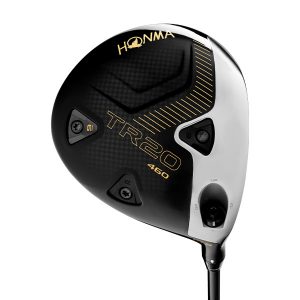Japan is home to dozens of high-end, high-quality golf club manufacturers, only a few of which have most Americans ever heard of. Honma has been in the golf club business for over 60 years now, but they remain largely unknown to most American recreational golfers.
That’s too bad, given that Honma produces some very impressive sticks. I lent the last Honma driver I tested and reviewed to a buddy of mine—a scratch-handicap who bombs his drives. He hit it well but needed an X-stiff shaft. So he lent it to his father, a 65 year-old club pro who loved it so much that I’ve never seen it again.
Happily for me, I got my grubby mitts on a Honma TR20 460cc Driver ($599) – a model that came out in 2019/2020. I had long been intrigued with this model, as it sits firmly a-straddle the “player” and “game-improvement” categories. It’s got an ET40 carbon crown and a carbon sole surrounding a titanium frame, all of which combines into a light, immensely strong clubhead, whose Ti face features vertical grooves and variable thickness. There are three adjustable weight ports on the sole, and a no-rotation adjustable hosel that keeps the spine of the Vizard shaft precisely positioned no matter how you adjust the lie and loft.
What does this all mean? Well, in February, 2021, the top golf-testing website MyGolfSpy.com ranked the TR20 as the Most Forgiving driver it tested. And in the most recent Golf Magazine equipment testing, one of the club testers was quoted as saying, “This driver is a beast!” So what all the engineering—and some rather substantial coin—will get you is a powerful beast of a driver that will still do its level best to keep you in, or at least around, the fairway.
Playing the Honma TR20 460cc Driver
As I say, I was chuffed to get the TR420 into my hands and onto my home course. From the very first drive – long and down the middle – I could feel the exquisite feedback from the face, up through the Honma Vizard TR20-60 S-flex shaft, and into said hands. Contact in the sweetspot is so pure, I worried for a split-second that I had completely missed. If it weren’t for the sound, which is somewhat singular, I would barely have known I’d hit the ball. Contact toward the toe or towards the heel was similarly identifiable. I quickly got to the point where I would hit my drive, tell myself something like, “1-inch toward the toe” or “1/2-inch toward the heel and a ¼-inch low.” Then I’d check the ball mark on the clubface to see how accurate I was. The feel was so precise, those descriptors were remarkably accurate. My playing partners got irritated, to be honest, because I kept showing them.
But what of that forgiveness in the off-center hits? Well, here’s an example: The 330-yard 13th hole of my home course plays rather steeply uphill to a more level plateau that rises only slightly to the green. I blasted a drive with the TR20 into a faint breeze, and I felt the contact was perhaps half-way off the sweetspot – a bit of a toe-hook. The ball climbed into the breeze, carried the bunker some 210 yards up the right side of the fairway, and disappeared as it drew toward the center of the fairway. Once I walked up the hill (and caught my breath), I saw my ball 40 yards short of the green. Imagine if I had made pure contact!
The Verdict
The Honma TR20 460cc Driver lives up to its billing as both “a beast” and as “most forgiving.” Think: The Incredible Hulk in Endgame. I can think of no driver I’ve ever hit with better feel and feedback. And it’s plenty long—plenty. None of Honma’s gear is cheap – but no premium equipment is. So don’t let lack of name recognition deter you if you’re looking to upgrade your clubs. Honma knows what it’s doing.

